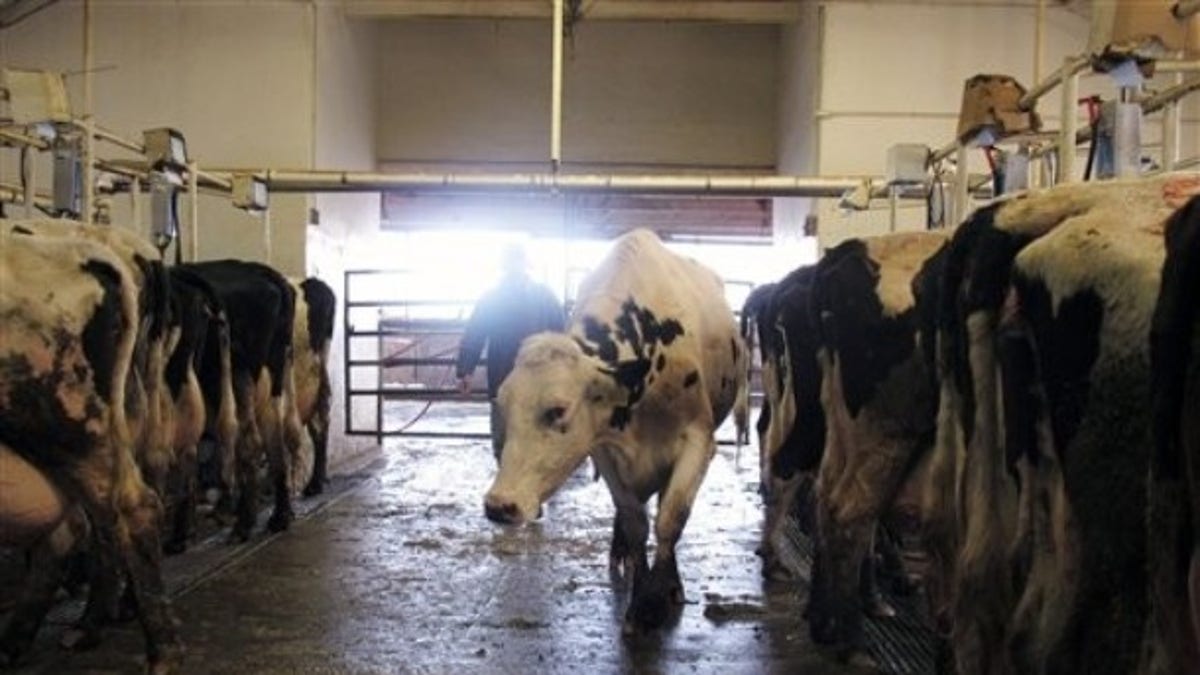
In this photo taken March 14, 2011, Ediberto Larios, a dairy worker at Golden Genes Dairy, prods a cow into a milking chute in Riverdale, Calif.
Milk may do the body good, but tax hawks and consumer advocates say a recently-proposed overhaul of subsidies for the dairy industry would fatten up the federal budget and boost milk prices for everyone.
Supporters in Washington, however, say the global recession -- which hit the dairy industry so hard that many farmers were forced to cull their herds -- has skimmed any incentive to stay in business, and federal help is needed to keep farms from utter devastation.
Recent letters sent by the National Taxpayers Union, Americans for Tax Reform and Citizens Against Government Waste, all conservative groups, as well as the liberal Consumer Federation of America, ask the Super Committee on deficit reduction not to include a proposed Dairy Market Stabilization Program in its bill.
"The Dairy Market Stabilization Program is specifically designed to increase milk prices," the CFA wrote last week to the leaders of the Senate and House committees on Agriculture. "This means that consumers would pay higher prices for milk and milk products than they otherwise would.
"As milk and dairy prices increase, low-income consumers are hit especially hard, since they spend a higher percentage of their income on food than other consumers," CFA wrote, adding that research shows that as milk prices rise, milk consumption falls, which could lead to calcium deficiencies for many Americans.
The conservative groups, taking a different tack, wrote that artificially inflating milk prices through subsidies "will ratchet up budgetary pressures on the government's food and nutrition programs."
"Elected officials should seek to eliminate, not exacerbate, unnecessary spending," they wrote. "The DMSP cannot be fixed and should be rejected. Programs like the DMSP have no place in any bill, and particularly not in a bill to get our country's fiscal house in order."
The 12-member Super Committee, which has until Thanksgiving to reach a deal, has said very little about the closed-door sessions they have been holding since last month to find $1.2 trillion to trim from the federal budget over the next decade. They held their second public hearing on Wednesday as competing plans were leaked offering broad details about the programs and targets for cuts.
The DMSP would allow the government to limit how much milk is produced when profit margins shrink to a certain level. It is part of a three-prong plan authored by Minnesota Rep. Collin Peterson, the top Democrat on the House Agriculture Committee, to strengthen the safety net for dairy farmers who were devastated in 2009 from the worldwide effects of recession.
Peterson’s dairy reform plan was unveiled in July and introduced as legislation in September. It would eliminate two federal programs -- the Dairy Product Price Support Program (DPPSP) and the Milk Income Loss Contract Program (MILC) -- and bulk up an insurance-like program in which the government pays farmers when milk profits become too slim.
The Congressional Budget Office has estimated that Peterson’s bill would save taxpayers $167 million over five years and $131 million over 10 years, according to Jerry Kozak, president and chief executive of the National Milk Producers Federation.
Peterson’s proposals were based on the recommendations of the Dairy Industry Advisory Committee, a panel of dairy farmers, industry leaders and academic researchers appointed by Agriculture Secretary Tom Vilsack to find solutions to help strengthen a vulnerable dairy sector.
Peterson, who says the current subsidy formula is outdated and won’t protect farmers from another dairy crisis, has been pressing Congress to launch the DMSP before the farm bill is due next year.
“If we have another crisis like we had in 2009; when milk prices dropped and input costs skyrocketed, I fear we could lose half our dairies,” he said last month. “The dairy safety net did not work then and it won’t work if similar events occur now. Producers cannot wait for another crisis or a new farm bill for Congress to fix the broken dairy safety net.”
Peterson's office did not respond to repeated requests for comment.
In 2009, milk prices fell off a cliff, wiping out years of savings and dragging under hundreds of dairy farms. Milk prices, which had been inflated by demand in developing nations, fell from a high of $18 per 100 pounds in 2008 to about $12 per 100 pounds in 2009. Desperate to weather the storm, farmers began slaughtering their cows to try to cut production and pleaded with the government to act to stabilize the industry.
The price of milk rebounded last year to $16 per 100 pounds. Milk is expected to average about $20 per 100 pounds this year and about $18 per 100 pounds next year, based on milk production.
Milk consumption in America has been on a steady decline for at least the last 60 years. Americans drank slightly more than 20 gallons of milk per person as of 2005, down from 36 gallons per person in the 1950s, according to the USDA.
Each year, the USDA supports the prices for dairy products by purchasing cheddar cheese, butter and nonfat dry milk that is then used in several food subsidy programs, including school lunches and military and veterans’ hospitals, or resold on the commercial market.
Before the 2009 crisis, the USDA spent more than $2.5 billion over five years on the MILC, which compensates dairy farmers when milk prices dip below a certain level, according to the Congressional Research Service.
The USDA has not taken a position on DMSP but Vilsack told the Milwaukee Journal Sentinel in August that Peterson’s proposal might not be “exactly right, but it’s certainly a really good start and it identifies the issues that have to be addressed.”




